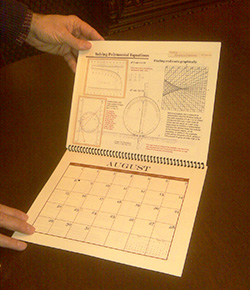 As you may have noticed, the history of graphical computing (nomograms and the like) has become one of the major themes of this blog. I did not foresee this, as I knew virtually nothing about the subject before I started researching my first essays on nomography a couple of years ago. This topic is still one of my main pursuits, and I’m as astonished by what I find now as I was back then. To capture a bit of this spirit, I’ve created a free 2010 calendar titled The Age of Graphical Computing that is available for downloading and printing. The fun thing is that you can test the examples right on the calendar to show that they work!
As you may have noticed, the history of graphical computing (nomograms and the like) has become one of the major themes of this blog. I did not foresee this, as I knew virtually nothing about the subject before I started researching my first essays on nomography a couple of years ago. This topic is still one of my main pursuits, and I’m as astonished by what I find now as I was back then. To capture a bit of this spirit, I’ve created a free 2010 calendar titled The Age of Graphical Computing that is available for downloading and printing. The fun thing is that you can test the examples right on the calendar to show that they work!
There are two formats available: two-sided 8-1/2″ x 11″ sheets of paper printed in landscape mode that can be connected at their edge as shown in the photo on the left, and two-sided 11″ x 17″ sheets of paper printed in portrait mode with two pages per side that can be folded as a group and stapled in the middle. Either of these could be printed to fit on A4 or other sizes, I’m sure. White paper can be used, but the color scheme is really designed for a light beige or ivory paper and it looks so much more professional when it’s printed on paper of some color (gray might work). The stapled format requires no other binding. As you can see from the photo on the left, I printed the first (non-stapled) format and took the printed sheets (24 lb. Southworth ivory linen paper from OfficeMax) to a local office shop (Kinko’s FedEx) and had them add clear plastic sheets to the front and back and install a spiral wire (a 60-second job that costs $5). Drilling a hole in the center along the top to hang it completes the calendar. Using 3 rings through punched holes along the top may be a cheaper option.
Small images of the front and back and each page of the calendar are shown at the bottom of this page. These provide only a rough idea of the content, but if you think you might be interested, the complete PDF file is just over 5MB, so it is easily downloaded and viewed at full resolution (for viewing you will want to download one of the first two PDF files listed below in which all pages but the back cover are right-side up).
Flip-Up Landscape Printing with Binding: The following two PDF files are designed for two-sided printing in landscape mode on 8-1/2″ x 11″ paper by default (choose the “flip up” mode of two-sided printing). Some sort of binding is required, as in the spiral binding shown in the photograph at the top. Note that the last page in the PDF file is upside down in order that the back of the calendar has the same orientation as the front cover.
The PDF of the calendar with major U.S. holidays can be downloaded here.
The PDF of the calendar with no holidays can be downloaded here.
Double Portrait Printing with Stapling: The following two PDF files are designed for two-sided printing in portrait mode with two pages per side on 11″ x 17″ paper by default (do not choose the “flip up” mode of two-sided printing). Note that the pages are in a strange order and are often upside down in the PDF file to provide the correct order and orientation when the packet of papers is folded and stapled in the middle.
The PDF of the stapled calendar with major U.S. holidays can be downloaded here.
The PDF of the stapled calendar with no holidays can be downloaded here.
In all cases the moon phases (shown as empty or filled circles) are referenced to U.S. Eastern Standard Time, or GMT-5, so the date could be off by a day depending on where you live.
Have a happy 2010!
Ron

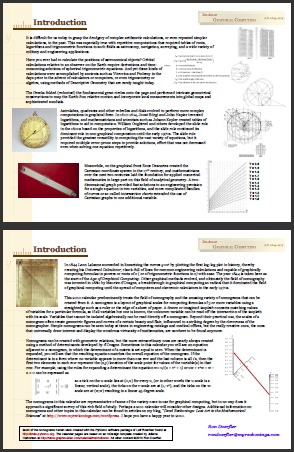


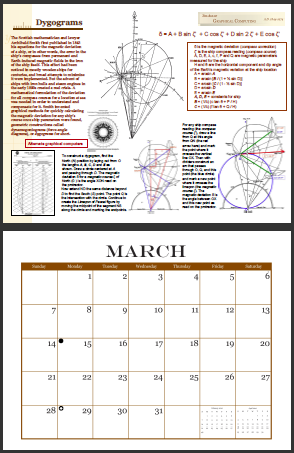
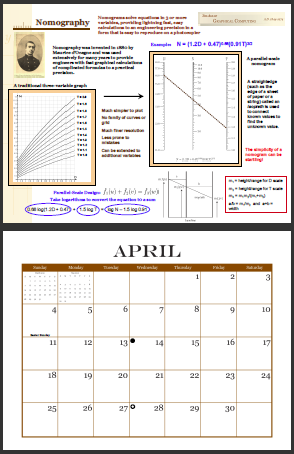



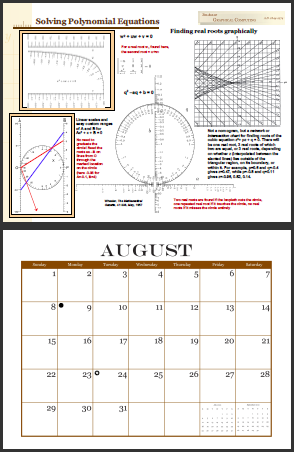


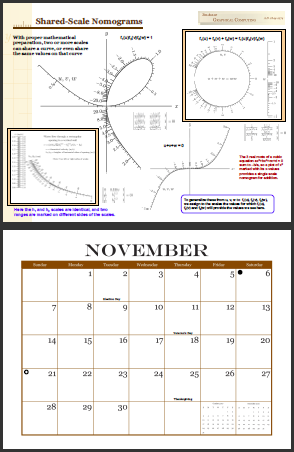

Hello Ron,
These are pretty amazing.
Have you considered selling them? I think printing in bulk is cheaper and anyway I wouldn’t mind paying a little over the cost of printing. If you collect enough interest and you’re printing some, let me know. I will buy a few (say 2-3).
Happy New Year!
David
Hi David. I’ve thought about it, but I don’t have the time to pursue anything right now. I’ll announce something here and drop you a line if I do. — Ron
LikeLike
I love this calendar — thanks much!
You’re welcome, and thanks for the tweet!
LikeLike
Thanks for a great looking calendar. As always your projects are multi-use.
Best,
Scott
LikeLike
I’ve appreciate very much this calendar. Very, very nice (and useful)
You’re quite welcome! — Ron
LikeLike
This is a very nice looking and very interesting calendar. Hope you keep it up in 2011. Thanks.
I appreciate that. With the nice responses I’ve received on this calendar, I’ve started to think about a 2011 calendar. Unfortunately, I haven’t decided if it will be on the same topic or a different math-related topic. — Ron
LikeLike
Very Nice, informative and good looking Calender . . .
Decided to print out one and hang in my office (to impress all 😉 )
That’s where I hang the calendar, right above knickknacks on my bookshelf such as a really nice slide rule, a Moonstick and a few ferrite core memory boards. Along with pictures on the wall of sundials and astrolabes, as well as a Personal Astrolabe, they evoke quite a few comments and interesting discussions. — Ron
LikeLike
Maravilloso y gran trabajo de recopilación. Ya me pusieron a estudiar. Gracias
Gracias por sus palabras amistosas, Francisco. En noviembre voy a publicar un nuevo calendario para el 2011 sobre el tema de cálculo mental. — Ron
LikeLike
Hi Ron,
Your calendar is beautiful.
Thanks, liunian. Nice to hear from you again! Are you designing more nomograms? — Ron
LikeLike
Sadly, I only found this now, via the Make blog post. Not too useful as a calendar anymore, but still great as a…pamphlet? Is there an easy way to just get the top halves without the calendar pages?
Hi David. I’ve had some people ask about the calendar, so I will be re-releasing it for 2011 in the next month. I’ll also edit the source (believe it or not I made this in PowerPoint, which was painful) to remove references to being a calendar and also release it as a pamphlet or somesuch. My intent this year was to make two calendars for 2011, one on mental calculation and one on more advanced examples of nomography, but the first one took much longer than I thought it would. The 2011 mental calculation calendar will be appearing here for download in the next month along with the re-release of the nomography calendar for 2011, while the new nomography calendar will have to wait until next year at this point. 😦 — Ron
LikeLike
Yeah, same here about the Make: article… Of course if you still have the raw file, we could change the dates on our own.
Hi Thom. See my response above. I’ll be updating the calendar pages and releasing it for 2011. Thanks for asking! — Ron
LikeLike
Simply awesome Ron. Too bad I discovered your calender in October. 😦
Your site has been bookmarked and I will be looking forward to the 2011 version.
-Hamlet
Now you’ve all got me wishing I’d done my 2011 calendar on nomography! I hope you’ll like the one I’m working on now anyway, and next year I’ll make a new 2012 calendar on graphical calculation (promise). — Ron
LikeLike
i love the calendars
do you have something available for this year, 2012?
thanks
greetings
Unfortunately, despite my best efforts to not break a two-year tradition, I simply couldn’t get a calendar together by the end of the year. I’ve been involved in multiple projects related to the blog as well as other family matters, and the deadlines just didn’t allow it. I’ll be starting to work soon on one for next year, though. It’s a niche thing about my blog that I like. Thanks for the compliment, though! — Ron
LikeLike
This calendar is great, and would be a perfect gift for my father-in-law! Perchance, do you have it in an editable file, such as ppt, so that I can use this same exact calendar but change the cover year and the months to correspond to 2012?
Thanks!!
Hi Kerri. Sure, that’s no problem at all. I’m glad you like it—in the end I was not able to create a new calendar for 2012 (thus breaking a two-year tradition!), but I hope to post one later this year for 2013. The PowerPoint files can be downloaded from these links:
Graphical Calculation Calendar with Holidays
Graphical Calculation Calendar without Holidays
As I recall, I converted these to PDF using an Acrobat Pro interface within PowerPoint, and then rotated the final page 180 degrees in Acrobat Pro itself so it was printed correctly for the “back cover”. But you can also print these directly from PowerPoint after you make your edits, I’m sure, as long as your margins are kept small (I think I set them to be 1/4″). Let me know if you have any questions. — Ron
LikeLike
The art of nonograms! These look great on the calendars Ron.
LikeLike
Any chance you can print out the same calendar, simply for 2019? So lovely!
LikeLike
Hello Ron! I liked your book “Dead reckoning: calculating without instruments.” I don’t have email (too much spam for my liking, as you note) but you can contact me by telephone on (+44)(0)7946 607 280. This comment is about an everlasting year-to-view calendar which anyone can commission (or DIY if they possess simple woodworking skills). My idea is that you could make a downloadable pdf of what needs to be printed on the pieces (see “printing” below), which can be stuck on rather than printed directly (e.g. by silk screen) on them.
As it’s perpetual, the bank holiday information becomes out of date, but it can be presented e.g. as follows for England and Wales:
Bank holidays at present are:
Jan. 1; Jan. 2 (if Monday); Jan. 3 (if Monday); Monday after Easter; first Monday in May (exceptionally in 2020 moved to May 8); last Monday in May; last Monday in August; Dec. 26; Dec. 27 (if Monday or Tuesday); Dec. 28 (if Monday or Tuesday).
Additional public holidays are:
Friday before Easter; Dec. 25.
Summer Time begins at 1 a.m. GMT on the last Sunday in March and ends at 1 a.m. GMT on the last Sunday in October.
Note: The European Union is currently considering a draft directive under which the twice yearly adjustment of clocks will cease from 2021.
The mathematical theory has been developed to the extent that the calendar can be changed from one year to the next without thought by following instructions in either narrative or flowchart form. I’m not copying them here at the moment as you might like to see if you can build a calendar for (say) 2019 without them.
SPECIFICATION
Piece 1: Hardboard base 10 5/8″ high x 6 3/4″ wide. In the centre of the top edge is a pierced semicircular projection 3/4″ in diameter for hanging.
Piece 2: 2-ply wooden board bonded to Piece 1 so that its top, left and right edges are flush with the corresponding edges of Piece 1. This means that in the centre of the top edge is a pierced semicircular projection 3/4″ in diameter. The hole must align with the hole in Piece 1. The top ply extends 1/2″ from the top of the baseboard while the bottom ply extends 3/8″ from the top of the baseboard. A flange is thus created under which the date pieces slide. There is a precisely similar arrangement with Piece 6 (see below for the dimensions of pieces 3, 4 and 5) but here the bottom edge aligns with the bottom edge of Piece 1 and there is no projection.
Pieces 3, 4 and 5 are similar but there is a flange beneath both top and bottom edges. As all flanges are 1/8″ wide this means that in these pieces the bottom ply is only 1/4″ from top to bottom compared to 3/8″ in pieces 2 and 6. Pieces 3, 4 and 5 are bonded to the backboard so that the gauge (the separation between (1) the bottom edge of the bottom ply of Piece 2 and the top edge of the bottom ply of Piece 3, (2) the bottom edge of the bottom ply of Piece 3 and the top edge of the bottom ply of Piece 4, (3) the bottom edge of the bottom ply of Piece 4 and the top edge of the bottom ply of Piece 5, and (4) the bottom edge of the bottom ply of Piece 5 and the top edge of the bottom ply of Piece 6) is a little over 2 1/4″.
Pieces 7 to 24 are the pieces with the days of the week and the dates. They are wood, single-ply and 2 mm thick. In all these pieces the height of the day/date display is 2″, but the pieces themselves are 2 1/4″ high because there is a 1/8″ border at top and bottom which engages with the flange. The width of pieces 7 – 13 is 2 1/4″ – these pieces are therefore square. The width of pieces 14 – 24 is 4 1/2″.
OVERVIEW
In appearance the calendar is similar to an ordinary year-to-view calendar with the months arranged in four rows of three. The pieces containing the days of the week and dates (nos. 7 – 24) slide into position in the channels.
PRINTING
The names of the months are printed on pieces 2, 3, 4 and 5, in order, suitably spaced, three months to each piece. The back of Piece 24 is not printed with dates but with the following rhyme:
“Thirty days have September,
April, June and November.
All the rest have thirty-one
Excepting February alone,
Which hath but twenty-eight days clear
And twenty-nine in each leap year.
For leap year, coming once in four,
Gives February one day more.”
Pieces 7 – 13: Piece 7 shows on the front a 31 – day month beginning on Sunday with on the back a 31 – day month beginning on Monday. Pieces 8 – 13 show similar months beginning on successive days of the week with the 31 – day month on the back always beginning a day later than the 30 – day month on the front.
Pieces 14 – 24: Piece 14 shows on the front a 31 – day month beginning on Sunday followed by a 28 – day month beginning on Wednesday. The back is identical except that the second month has an extra day. Pieces 15 – 20 show months beginning on successive days of the week as before. Piece 21 shows on the front a 31 – day month beginning on Monday followed by a 30 – day month beginning on Thursday with on the back a 31 – day month beginning on Thursday followed by a 30 – day month beginning on Sunday. Piece 22 shows on the front a 31 – day month beginning on Tuesday followed by a 30 – day month beginning on Friday with on the back a 31 – day month beginning on Friday followed by a 30 – day month beginning on Monday. Piece 23 shows on the front a 31 – day month beginning on Wednesday followed by a 30 – day month beginning on Saturday with on the back a 31 – day month beginning on Saturday followed by a 30 – day month beginning on Tuesday. Piece 24 shows on the front a 31 – day month beginning on Sunday followed by a 30 – day month beginning on Wednesday. The back is printed with a rhyme, as explained above.
LikeLike
In my comment of 23 August 2019 (penultimate paragraph) the phrase “Piece 7 shows on the front a 31 – day month” should read “Piece 7 shows on the front a 30 – day month.” As regards the “two-ply wooden board” used to make pieces 2, 3, 4, 5 and 6 the bottom ply must be just over 2 mm thick (so the date pieces fit snugly under the flange). For logistical ease the top ply can be the same thickness.
The procedure for changing the calendar from one year to the next “without having to think about it” is slightly easier when changing to a common year (procedure 1 in the flowchart) compared to changing to a leap year (procedure 2 in the flowchart). Therefore the user may, if she wishes, perform procedure 1 twice rather than procedure 2 once. Take special care when manipulating the January/February piece (piece “A”). If you have regard to the following two extracts from the leaflet giving the instructions in narrative form you can’t go wrong.
Extract 1
Common or leap year to common year (example 2020 to 2021):
Piece A starts on Wednesday and ends on Saturday. It returns to the box [“the box” here means the receptacle where the reservoir of pieces which are not required for display in a particular year is stored], being replaced by a 31/28-day piece starting two days later in the week (if the display is being changed from leap year to common year) or one day later in the week (if the display is being changed from common year to common year).
Extract 2
Common year to leap year (example 2019 to 2020):
The following sequence may be followed, or alternatively the above sequence may be performed twice in succession, in which case it should be remembered on the second occasion simply to turn over piece A instead of replacing it.
LikeLike
Hi thanks for posting thiis
LikeLike